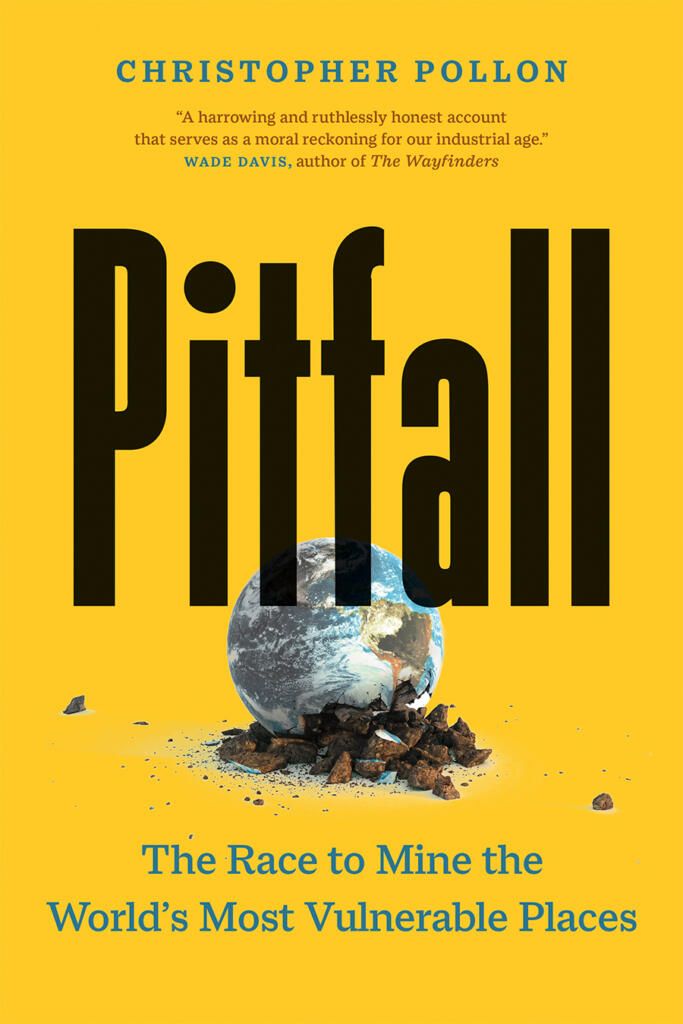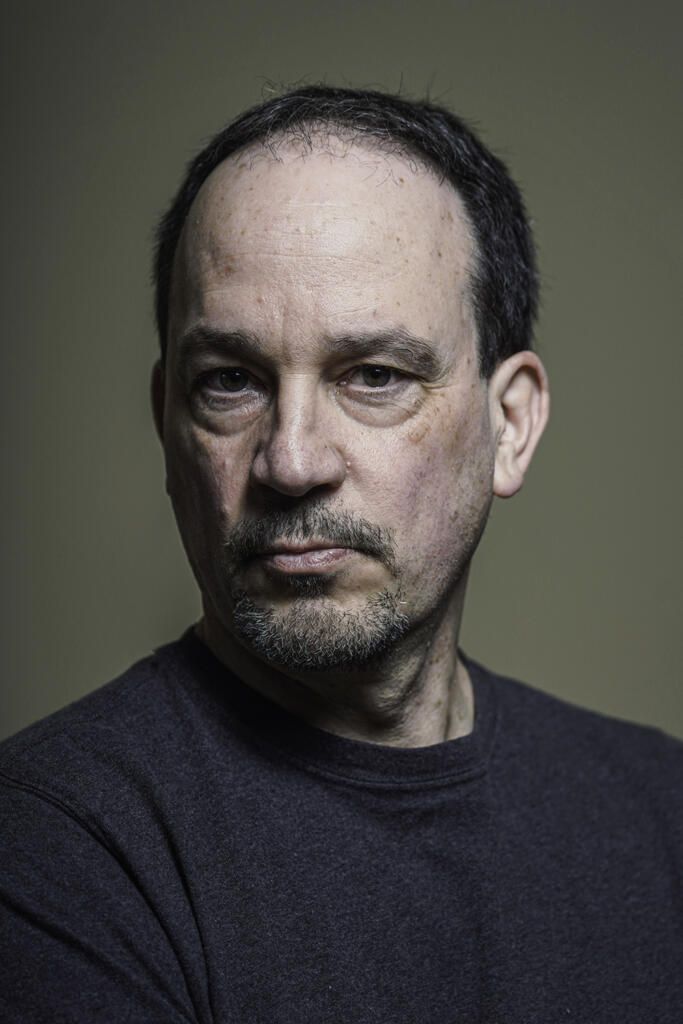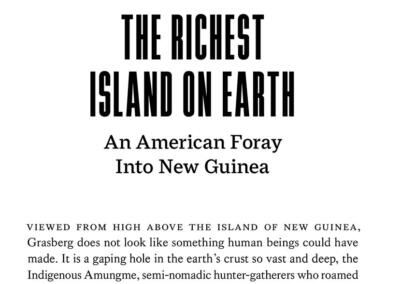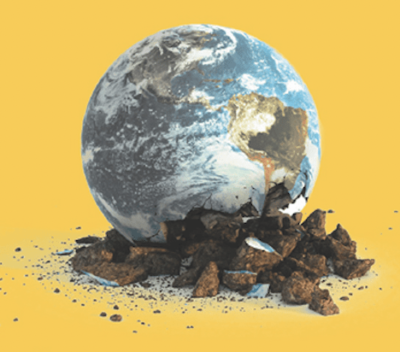What should we extract?
Pitfall: The Race to Mine the World’s Most Vulnerable Places
by Christopher Pollon
Vancouver: Greystone Books, 2023
$39.95 / 9781771649124
Reviewed by Alexandra Pedersen, PhD
*

The term “sacrifice zones” conjures images of a toxic landscape left permanently barren by rapacious capitalism; consumed until there is nothing left with no possibilities, no hope for the future. Billionaires, their companies, international banks, and aligned governments tell the masses that these ‘zones’ are a necessary cost for saving the planet. Those with this power tell voters, investors, and news outlets that we need to dig deeper, open new mines, and find new frontiers on land, in sea, and outer space if we are to save the planet. More ironically, the responsibility of saving our species is downloaded to individuals in wealthy countries to buy electric vehicles (EV), while those who live directly above or downstream of the critical minerals needed for EV batteries face the highest costs for our greed.

Journalist Christopher Pollon calls on readers of Pitfall to face a wicked problem, or in other words, a dilemma with no seeming solution. We need metals and minerals to build solar, wind, and other energy infrastructure, but to get those resources we must damage the environment and in turn harming those who live adjacent (humans, plants, insects, and animals alike). Who decides what places – or whose homes – are sacrificed for the “green” revolution? Pitfall represents a critical narrative of the Anthropocene – a call to those who have not yet stopped to ask the question “where did all these metals come from?”
Pollon skillfully connects the colonial, imperial, and neocolonial experiences of mining and energy infrastructure across the globe. The book strategically presents unique yet intersecting case studies covering countries in Latin America, Africa, Asia, and Oceania to demonstrate exploitation from transnational corporations from Canada, the United States, Australia, China, and Russia to name a few. The control over and access to metals and minerals has been inequitable to say the least. Pollon’s sustained interest from his decades worth of journalism (and an earlier book) on natural resources, energy, mines, and oceans make his work a must-read not just for the public, but for those involved in the mining sector as well.
Pitfall draws on case studies from over twenty-five countries and nearly every continent (save Antarctica). Pollon presents the book in three sections starting with the “Founding Sacrifice Zones” in a post-Second World War era of global mining. Rich case studies from New Guinea, Guatemala, and Mongolia build the reader’s understanding of how transnational corporations emerged in the Global South to exploit profit while imposing control over lands and resources (including people). Although not overtly theoretical (to the benefit of his readers), Pollon’s writing elevates a critical development perspective that links environmental destruction, political impunity, the trampling of Indigenous rights, and elevated violent conflict to mining operations. Underpinning much of Pollon’s writing is his understanding of structural violence and how companies, international banks, and governments, all funded, wrote policies, and protected mining to “develop” areas of the globe perceived to be underdeveloped. Pollon’s thorough and comprehensive study of these founding zones sets the stage for a long-debated question for some resource-rich nations: Are natural resources a blessing or a curse?
By the second section, “Business as Usual”, Pollon presses hard on promises made by the mining industry that extractive operations lift communities out of poverty. He writes: “Citizens across the global south are struggling to achieve lasting prosperity from the riches that surround them – including the copper, lithium, and cobalt needed for clean energy.” To exemplify this claim, Pollon focuses quite a bit on Latin America in this section and then draws in experiences from Africa. For example, in Bolivia, a country with one of the highest populations of Indigenous Peoples and legacies of colonial violence, present-day conditions keep inequality high while the lithium has many clamoring for the new ‘white gold.’ Meanwhile, Chile – a country internationally known for having the world’s largest copper reserves – has suffered a fifteen-year drought. Water scarcity is a factor intersecting many of Pitfall’s case studies, which is relevant knowing that mining operations use significant water reserves that might otherwise be used for public consumption, food systems, or respected as an essential part of the environment. By the end of this section, Pollon uses a case study in the Democratic Republic of Congo to exemplify the tensions between artisanal or small-scale miners and transnational companies backed by banks and governments. The Democratic Republic of Congo, like many more countries exemplified in Pitfall, reveal patterns where mining and related financial activities thrived and companies strategized for further growth in the shadows of internal armed conflicts. After reading this book, one might ask how it is even possible to claim conflict-free minerals and metals in these cases?
Moreover, wider protests erupting over the last fifteen years have cost corporations and governments (and taxpayers) billions of dollars – an expensive lesson for willful ignorance. Most recently in October 2023, Vancouver-based mining company Quantum Minerals (the company is mentioned in Pitfall, but this event comes after publication) was allegedly at the epicentre of a national strike in Panama over plans to expand their copper mine. After reading Pitfall, you will not be able to unsee the links in the news between the metals we use and the conflicts arising at home and abroad.
In the final section, “Where do we go from here?”, Pollon turns to focus on the multiple futures that lay ahead, and the chapters focus less on deep country case studies and more on the state of mining globally. Circling back to Indonesia, Indigenous resistance in West Papua calls for a different type of “resource independence”, where the concept of “ecocide” – basically the action of intentionally or unintentionally harming the environment long term – may one day become a criminal offence. The themes of Indigenous resistance and resilience are amplified throughout Pitfall as alternatives to the current status quo; a proposal of a future that benefits everyone, not just the rich and powerful. Meanwhile, Pollon does his due diligence in speaking with mining company executives – some he says are representative of a new generation in the mining industry who focus more on environmentalism. However, like Pollon, we should remain skeptical of CEOs and companies who self-promote themselves as altruistic; by their very definition, structure, and core corporations are obligated to make profits over saving the environment. So where does that leave us in terms of our wicked question?

The current future proposed by the mining industry once again pushes humanity to new frontiers, but not in the name of science, but rather keeping up with the status quo. Artificial intelligence paves way for automated house-sized mining trucks and other autonomous machines that will do the low-skilled and dangerous work often promised to local communities as the means for their development. It will be increasingly interesting to see how the mining industry pivots, once again, to explain to communities what benefits operations may bring at the expense of local landscapes. Pollon points out at the beginning of the book, that a mine’s “negative externalities” – meaning the environmental costs to clean up the mines – outweigh the market price of a company’s value and therefore passed on or shift costs onto local populations, governments, and taxpayers. Often, these exorbitant costs were due to lack of environmental assessments, lack of scientific knowledge of the outcomes, or even environmental racism (described as inequality where low-income communities, often racialized, face uneven risk of exposure to pollution and related health outcomes).
Today, what is alarming is the cowboy mentality of prospecting, exploration, and extraction two of the furthest frontiers, deep seabeds and asteroids. Although Pollon points out that the concept of deep-sea mining has been around for centuries, technology is only now catching up to reach further depths on the ocean floor, an area not yet fully studied by scientists and with unknown environmental consequences in and out of sea. Likewise with asteroid mining, the sheer cost of space exploration begs the question of whether the money raised for space mining could not be better spent on solving the current crises of humanity. How will companies explain away the “negative externalities” of tomorrow if they cannot account for today’s? There are proposals for a circular economy approach and recycling of metals and minerals already extracted from the ground that represent new pathways forward to curb and address the current issues in mining that will be interesting to see expand as an alternative to mining deeper into new frontiers.
Pollon’s lasting call to readers is a radical, yet a practical proposal. “The idea of leaving valuable resources in the ground (or on the seabed) is a truly disruptive idea, and part of the way the world will need to change if mining is to evolve beyond being “unloved” – and emerge into something we can all live with.” Activists, governments (a nod to El Salvador’s ban on metallic mining in 2017), and Indigenous Peoples worldwide have been calling on moratoriums of mining for decades. Pollon’s call respects those voices and carries them forward when he suggests that we no longer mine for the sake of mining. Rather, he suggests that humanity extract only what is needed, carefully, and nothing more.

For Pollon and readers of Pitfall, hope lies in the lessons learned from the resilience and revitalization of Indigenous communities, organizations, and governments who are defending their rights as Indigenous peoples, and to the benefit of human and environmental rights globally. There is also great courage demonstrated by the plaintiffs in legal cases, which, at present, are the only real checks on corporate power. The industry has largely operated on voluntary principles and vehemently rejects regulations that infringe on their abilities to make more profits. Cases like those raised in Pitfall demonstrate why leaving the industry to regulate itself will not serve justice to individuals and communities harmed. One of the most profound examples of bravery and attempts towards corporate accountability comes from the three related cases involving the Indigenous Maya Q’eqchi’ communities around the Fenix nickel mine in El Estor, Guatemala. Widow Angelica Choc, German Chub Choc, and 11 women allege that the company’s security, Guatemalan military, and police assassinated local Indigenous leader Adolfo Ich (Angelica’s husband), shot and harmed German, and gang-raped all 11 women. For these grave harms, each case seeks reparations from Hudbay Minerals Inc. Filed in 2010-2011, all three of these precedent-setting cases have yet to be closed. Cases like these are beacons of hope, but the wait for justice is excruciating. While plaintiffs receive threats and intimidation to drop their cases, these same companies continue operations and reap the benefits of their violence.
In summary, Christopher Pollon’s Pitfall calls on us to wake up and see the impacts of mining around the world and to imagine a different future. Our wicked problem for the future remains: How do we secure the metals needed for our current civilization without destroying the environment, tipping politically fragile states, violating the rights of Indigenous Peoples and the most vulnerable in society? Let’s not let the CEOs decide.
*

Alexandra Pedersen, has a PhD in human geography from Queen’s University and is an instructor in the Masters of Earth and Energy Resource Leadership (MEERL). Her academic and activist research amplifies perspectives of development and community resistance to Canadian mining companies in Guatemala. She is a co-chair of MiningWatch Canada’s Board of Directors and an active beekeeper in her spare time.
*
The British Columbia Review
Interim Editors, 2023-24: Trevor Marc Hughes (non-fiction), Brett Josef Grubisic (fiction)
Publisher: Richard Mackie
Formerly The Ormsby Review, The British Columbia Review is an on-line book review and journal service for BC writers and readers. The Advisory Board now consists of Jean Barman, Wade Davis, Robin Fisher, Barry Gough, Hugh Johnston, Kathy Mezei, Patricia Roy, Maria Tippett, and Graeme Wynn. Provincial Government Patron (since September 2018): Creative BC. Honorary Patron: Yosef Wosk. Scholarly Patron: SFU Graduate Liberal Studies. The British Columbia Review was founded in 2016 by Richard Mackie and Alan Twigg.
“Only connect.” – E.M. Forster






























